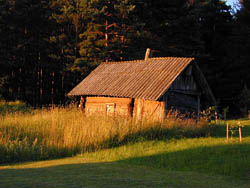Visaginas and Ignalina Nuclear Power Plant
|
| For the 3500, formerly 5000, workers at the Ignalina Nuclear Power Plant (INPP), the Soviets
built Visaginas town in 1975. It is not very inspiring, but rather looks like a pioneer village, an outpost, built
just because it was needed. It looks like a typical Swedish concrete suburb from the sixties. A giant radiation
meter with a metal stork in flight dominates the city centre. The rest of the city looks like it’s in bad need
of restoration. The power plant is not at all in Ignalina town. It’s quite far away, here at Visaginas. The nearby
lake, Druksiu, used as cooling water supply for the plant, looks inviting for bathing, fishing, water-skiing et
cetera. |
|

|
The meter showed 8 microRoentgens/hr when we came, and after some time it showed 9 and then 10. But it was probably
nothing to do with us... |

|
The Main street had seen better days. These high-risers happened to be the first ones erected, and the plaster
was now falling off, some six floors up. |
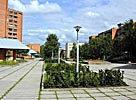
|
The main path, with its original, cracked Soviet concrete slabs still remaining, with the original grass still
in between, continued towards the newer parts of town. |
|
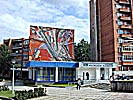
|
The Main street had a strange piece of art, that our guide figured would portray “Peaceful use of the atom”, but
at the same time he thought that the interpretation depended on the amount of beer inhaled. |
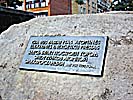
|
This large stone was put down before the town was built. The text reads: “A town will be built here for the nuclear
power plant workers. August 1975”. The stone's shape is said to resemble Lithuania. |
Empty
|
|
|
I just got to show you some pictures from inside the power plant.
|
|
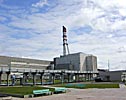
|
The picture shows reactor block 2. The three giant stacks are for venting away any hydrogen gas created in the
reactor, if you are out of luck. Oxy-hydrogen gas in the reactor hall is not very fun. At the very end is the skeleton
of block 3 that was never finished. |
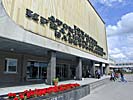
|
Our microscopic guided tour starts off outside the main entrance. It looks like an impregnable fortress. This is
the afternoon shift going in. It actually is an impregnable fortress. You will notice after having passed
the security check! |
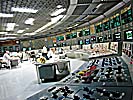
|
An unusually impressive control panel in the control room. It offers a good overview, but still, everything is
displayed on the computers. |
|
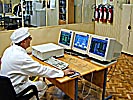
|
There is not much left in the computer room, or what was left of it after the old Soviet steam-driven computers
were scrapped and modern HP Alpha servers were brought in. The technician sits at a control terminal were he could
see everything happening in the plant, in a hierarchical troubleshooting system that turned out to be very powerful.
Note the parquet flooring. |
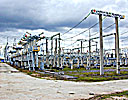
|
The distribution plant right outside is the most impressive I have seen. This is where most Lithuanian power is
routed from. |
Power Plant Factinos
The INPP produces 1.3 gigawatts of power, presently 87% of all the energy needed in Lithuania.
It has two reactor blocks, of which only block 2 is running. Block 1 was closed for good in the beginning of 2005,
whereas block 2, that was being restored in 2004 has been started and will run until 2009.
The EU has demanded that the plant be shut down, with reference to it being of the same type as Chernobyl. This
is not entirely true, as the INPP is a later model, and has been extensively modified by Western nuclear power
authorities. The features contributing to the Chernobyl accident have largely been eliminated.
As all of Lithuania’s and most of the Baltic power grid concentrates here in Visgainas a decision has been made
to build a modern nuclear power plant right here. There has already been preliminary studies to this end.
|
